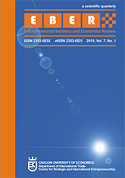The Behaviours of the Ukrainian Lending Rate, Deposit Rate, and Intermediation Premium
The Behaviours of the Ukrainian Lending Rate, Deposit Rate, and Intermediation Premium
Author(s): Chu V. Nguyen, Oksana HoncharenkoSubject(s): National Economy, Evaluation research, Transformation Period (1990 - 2010), Present Times (2010 - today), Financial Markets
Published by: Uniwersytet Ekonomiczny w Krakowie
Keywords: commercial banks; lending rate; deposit rate; intermediation premium; exogeneity; Granger causality; Ukraine;
Summary/Abstract: Objective: The objective of this article is to investigate the behaviours of the Ukrainian lending rate, deposit rate, and intermediation premium from January 2000 to January 2019, or the post-1999 era. Research Design & Methods: The Perron’s (1997) endogenous unit root test, the Threshold Autoregressive model, and the Threshold Autoregressive Vector Error-Correction model are utilized to investigate the short-run dynamic and the long-run relationship between the commercial banks’ lending and deposit rates to evaluate the intermediating function of the Ukrainian lending institution. Findings: The intermediation premium followed a stationary trend process with a structural break in July 2004. The Ukrainian banks react symmetrically to expansionary monetary policy and contractionary policy or economic shocks that pushed the intermediation premium out of its long-run path. Finally, the Granger-causality from the Ukrainian commercial banks’ lending to the deposit rates is unidirectional, indicating the exogeneity of their lending rate from their deposit rate. This exogeneity hinders monetary policy, investment, and economic growth and, hence, social progress. Implications & Recommendations: The policy-makers should introduce programs to remove exogeneity from the banking sector. Policy prority should focus on rectifying pervasive corruption, which is one of the major causes for the operation of the shadow banking industry leading to the exogeneity in the economy. Contribution & Value Added: As far as it may be ascertained, there is no similar study; therefore, the methodology and findings of this investigation will close this gap in the literature and significantly contribute to the knowledge and literature.
Journal: Entrepreneurial Business and Economics Review
- Issue Year: 8/2020
- Issue No: 1
- Page Range: 143-158
- Page Count: 16
- Language: English

